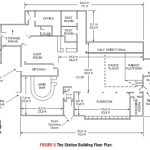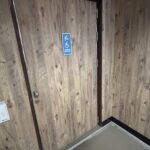Last week I visited an art and music space housed in an old cooking oil factory in Havana, Cuba. After dark it becomes a nightclub, where visitors can dance to live music or a DJ, check out the art, eat, drink, and hang out with friends. There were thousands of people in this giant building with multiple different rooms and no rhyme or reason to the egress paths. There were spaces that I would not enter, knowing what I know about nightclub tragedies. On Wednesday I will share a few photos from the venue.
 Today is the 20th anniversary of one of the worst nightclub fires in US history – at the Station Nightclub in West Warwick, Rhode Island. For those of you who may not be familiar with this tragic event, I am sharing some resources that I previously posted here on iDigHardware, along with some additional information. This fire resulted in 100 deaths and more than 200 injuries, and the doors played an important role.
Today is the 20th anniversary of one of the worst nightclub fires in US history – at the Station Nightclub in West Warwick, Rhode Island. For those of you who may not be familiar with this tragic event, I am sharing some resources that I previously posted here on iDigHardware, along with some additional information. This fire resulted in 100 deaths and more than 200 injuries, and the doors played an important role.
As I’ve said before (and will likely say many more times)…to honor the lives lost in these tragedies, we must learn from them. The video below from the City of Mississauga’s series ‘On This Day in Fire History’ provides a good overview of what occurred at the Station Nightclub as well as some recommendations that could help save lives:
The next time you’re at a bar or nightclub (or any venue, really):
- Walk the layout of the building when you first arrive
- Look for two ways out of each room and identify marked fire exits
- Look for fire extinguishers and sprinkler systems
If you notice…
- Overcrowding
- Blocked or unmarked exits
- Fire hazards
- Anything that makes you feel unsafe
…LEAVE
An article from Building Safety Journal – Remembering the Station Nightclub Fire – details what went wrong at the Station Nightclub, lessons learned, and resulting code changes. The configuration of the club’s egress doors contributed to the number of fatalities:
The design of the front entrance corridor contributed to the loss of life, forcing concert-goers to push through an intermediate door that opened into a small foyer before finally reaching the main doors that led outside. The cramped foyer was reportedly designed to prevent people from entering the club without a ticket, but it proved disastrous when the large, panicked crowd clogged it in a desperate attempt to escape the blaze. People stampeded into the area through entrances from the bar and club. In the panic to get out, many fell and were trampled. Falling patrons jammed the main exit, trapping the people behind them inside. In the confusion, others fled blindly, finding themselves trapped in places like bathrooms with no means of escape. Three other exits were open and marked with lit signs in other parts of the club, but most people never realized they were there. An exit near the stage was quickly eliminated as the fire spread around the door, preventing escape.
The National Institute of Standards and Technology (NIST) published a 2-volume report on the fire, which is available on their website. From the NIST report:
A fire occurred on the night of Feb. 20, 2003, in The Station nightclub at 211 Cowesett Avenue, West Warwick, Rhode Island. A band that was performing that night used pyrotechnics that ignited polyurethane foam insulation lining the walls and ceiling of the stage platform. The fire spread quickly along the ceiling area over the dance floor. Smoke was visible in the exit doorways in a little more than one minute, and flames were observed breaking through a portion of the roof in less than five minutes. Egress from the nightclub, which was not equipped with sprinklers, was hampered by crowding at the main entrance to the building. One hundred people lost their lives in the fire. Of the fatalities, 95 were due to the inability of the occupants to evacuate before being overcome by the untenable conditions along the egress path.
The National Fire Protection Association (NFPA) has published information about nightclub tragedies on their website, including a video about nightclub fire safety, and a safety tip sheet on places of public assembly. NFPA also published a case study on nightclub fires, and the report includes information about the impact of this fire and other nightclub tragedies on the model codes:
On February 20, 2003, a fire in a small club in Rhode Island once again reminded us that history can and will repeat itself. Throughout history, major fires resulting in large losses of life have occurred that have not only stirred the public conscience, but also moved the fire protection community to continue to refine our codes.
Refining the codes and standards is only part of the solution. These tragic fires and the accompanying loss of life often result from the same contributing factors which include highly combustible interior finish, combustible contents including decorative features, lack of properly designed and adequate egress systems, and overcrowding of occupants. In assembly occupancy fires, many of these contributing factors have been addressed in the codes for generations. The methods in our existing codes are based on sound protection principles that have stood the test of time.
Refining the codes is a continuing process that combines the technical advances of today with present-day societal attitudes. The second part of the solution is getting the codes adopted. The third, and perhaps most important part, is enforcing these codes.
The Station nightclub fire adds to the long list of tragic nightclub fires. Even with the strides made toward improving safety in assembly occupancies, we are reminded that this battle is far from won. On December 30, 2004, a fire caused by pyrotechnics (fired by a patron of the club) resulted in 194 deaths and over 700 injuries in an overcrowded club in Buenos Aires, Argentina.
If you have seen any other good resources related to the Station Nightclub fire or to nightclub safety, please leave a link in the comments.
Image: Javier Zarracina/Globe Staff
You need to login or register to bookmark/favorite this content.










[…] https://idighardware.com/2023/02/20-years-ago-station-nightclub-fire/ […]
[…] https://idighardware.com/2023/02/20-years-ago-station-nightclub-fire/ […]
[…] https://idighardware.com/2023/02/20-years-ago-station-nightclub-fire/ […]